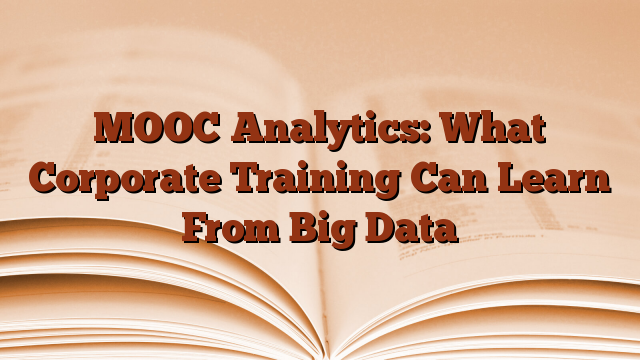What parts of your exercise program are most or least effective? When are your employees really engaged and when are they dreaming? Which training sessions/simulations/assessments/employee actions are most associated with learning? How does training affect the success of your employees and your organization? Would you like to be able to answer these questions? According to the ASTD 2012 State of the Industry Report, US companies spent more than $156 billion on training in 2011, which equates to an average of just under $1,200 per employee. For this type of dough, companies want to see some results.
MOOCs (Massive Open Online Courses) are currently reshaping the education and training landscape. In January 2013, the Harvard Business Review blog called “the advent of massively open online courses… the most important technological development of the millennium so far.” Did you get that? The most important technological development of the millennium so far.
Why are they making such a big impression? The reasons are varied and growing. Not only do they offer unparalleled scalability and access, challenging the long-held notion that content is king, but they can also serve massive amounts of user data. We’re not just talking about how long people spend on a particular task or who got which question right; We’re talking about the ability to track and analyze every aspect of the learning experience.
The current model in training analysis is “small data” – data based on reports, assessments, etc. from a small number of learners. But MOOCs can provide data from millions of people, and the data is collected at many different levels: the button press level, the question level, the learner level, the instructor level, the program level, and even the organizational level. This “big data” can be used to model characteristics and outcomes of learners and organizations, and most importantly, to predict future trends and patterns. It can help organizations determine which programs are working and which are not, where additional training is needed, and how best to deliver that training.
In a 2012 report on educational data mining and learning analytics, the US Department of Education’s Office of Educational Technology identified several questions that big data can help educators answer. Here are some of them:
- What sequence of topics is most effective for a given learner? When are learners ready to move on to the next topic?
- Which learner actions are associated with more learning? What actions indicate satisfaction, engagement, learning progress, etc.?
- Which features of an online learning environment lead to better learning? What will predict learning success?
- When is intervention required?
When the entire learning process takes place online, the entire learning process can be tracked and analyzed, and the data generated goes well beyond what is available in a classroom. Students in MOOCs don’t just watch videos and answer questions—they interact with each other and the instructor through discussion forums, social networks, blogs, and many other streams, leaving long and rich trails of digital data. This data can reveal trends and patterns that cannot be seen in traditional formats, and it allows us to go beyond what people learn and learn how they learn. Coursera co-founder Daphne Koller said: “Having this really big data set gives us insights into how people learn, what they understand, what they don’t understand, what are the factors that lead to some students understanding and others not , which I think is unprecedented in the field of education.”
This knowledge can be used to enhance both instructor-led training (ILT) and online learning. Here are some key areas where big data from MOOCs can influence training practice:
- improve results. This is the obvious. Of course, the goal of all training is to increase employee skills and effectiveness. MOOC data can be analyzed at both a micro and macro level to improve individual and organizational outcomes.
- clustering and relationship mining. Both of these concepts have to do with discovering relationships between variables. The data can be used in many ways, for example to organize employees with complementary skills in teams and work groups.
- Customize programs on a large scale. MOOCs started out as a one-size-fits-all solution, but they’re quickly evolving into adaptive learning environments tailored to individual learners. In the near future, the learning experience will be optimized individually and in real time.
- Predicting future trends. What is the return on investment (ROI) for your training program? Big data will help organizations predict the impact of training programs on the success of individuals, business units and organizations.
Businesses are already using big data to make decisions about sales, financial services, advertising, risk management, pricing, supply chain management – you name it. But until MOOCs came along, most organizations couldn’t collect enough data to make decisions about their training programs. Now data is being collected from millions of learners in virtual educational and corporate classrooms across the web.
The field is very new and educators are just beginning to realize the importance of having this data available. In a first attempt to quantify this learning experience, Duke recently published a report on its first MOOC. The results provide insight not only into student performance, but also into their activities and outcomes, motivations and attitudes, and the factors that facilitate and hinder learning. As more organizations collect, analyze and (in true MOOC spirit) share their data, we will begin to develop new models to increase the efficiency and effectiveness of teaching. Smart companies will use this data to ensure they get the best possible return on investment for their training programs so they have something to show for that $156 billion.
So you’re now convinced that the learning framework is the way to go and that Big Data will change your approach to training, but you don’t know where to start implementing it? Don’t worry – there’s a MOOC for that!
Thanks to Bryant Nielson | #MOOC #Analytics #Corporate #Training #Learn #Big #Data

Leave a Reply